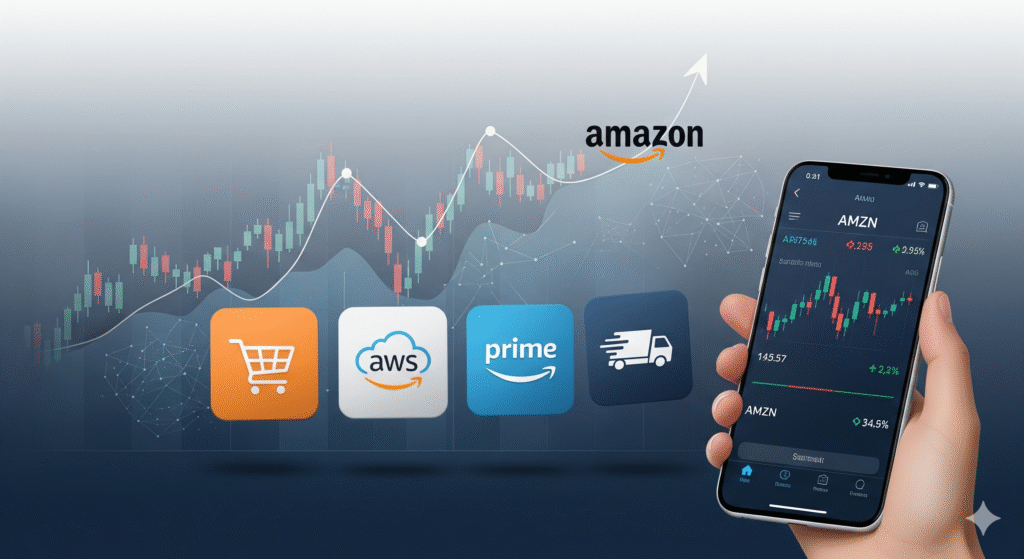Hey there, fellow investors!
If you’re like me, you’ve probably been scrolling through stock charts at 2 AM, wondering which companies are worth your hard-earned cash. Well, grab a coffee because today we’re diving deep into one of the most talked-about stocks on the market: Amazon stock (NASDAQ: AMZN).
When I started investing five years ago, Amazon stock felt like an untouchable giant that was “too expensive” for a regular person like me. Boy, was I wrong about that mindset! Today, I want to share everything I’ve learned about Amazon stock, from why it’s still relevant to how you can invest in it (spoiler alert: you don’t need thousands of dollars).
What Makes Amazon Stock So Special?
Let’s start with the obvious: Amazon isn’t just an online bookstore anymore. Remember when that’s all they were? Yeah, I was probably too busy figuring out how to dial up the internet back then.
Amazon has transformed into what I like to call a “business octopus.” It has tentacles in practically everything: e-commerce, cloud computing (AWS), streaming services, logistics, advertising, and grocery stores. This diversification is exactly why Amazon stock has been such a powerhouse.
The AWS Cash Cow
Here’s something that blew my mind when I first discovered it: Amazon Web Services (AWS) is the company’s most significant profit driver. While we’re all busy clicking “add to cart” on Amazon.com, the real money comes from providing cloud services to other businesses.
AWS powers everything from Netflix to Spotify, and it’s growing like crazy. In fact, when I look at Amazon’s quarterly reports (yes, I read financial statements for fun), AWS consistently shows impressive growth rates. This isn’t just about selling products online anymore; it’s about being the backbone of the internet.
Prime’s Sticky Ecosystem
Let’s talk about Amazon Prime for a second. Raise your hand if you’ve ever tried to cancel Prime and found yourself thinking, “But what about free shipping?” raises own hand sheepishly.
This InvesInvestorssmoat moateps customers returning and competitors out. Prime members spend significantly more than regular customers, and once you’re in the ecosystem, it’s hard to leave. Trust me, I’ve tried convincing my spouse we don’t need Prime. That conversation didn’t go well.
The Not-So-Perfect Side of Amazon Stock
Now, I’m not here to blow sunshine up your investment portfolio. Amazon stock has its fair share of challenges, and any honest review must address them.
Valuation Concerns
Amazon’s price-to-earnings ratio has historically been higher than that of traditional retailers. This means you’re paying a premium for future growth potential. Some investors love this; others think it’s overpriced. I fall somewhere in the middle. The premium is justified, but I also don’t throw caution to the wind.
Regulatory Pressure
Governments worldwide are taking a closer look at big tech companies, and Amazon is definitely on their radar. From antitrust concerns to labor practices, there’s always something in the news that could impact the stock price. It’s not a deal-breaker for me, but it’s definitely something to keep an eye on.
Competition is Heating Up
Microsoft’s Azure is breathing down AWS’s neck, and companies like Shopify are making it easier for businesses to compete with Amazon’s e-commerce dominance. Competition is healthy for consumers, but it can pressure profit margins.
How I Approach Investing in Amazon Stock
After years of watching Amazon stock from the sidelines and then finally jumping in, here’s my personal approach:
Dollar-Cost Averaging is Your Friend
Instead of trying to time the perfect entry point (spoiler alert: there isn’t one), I invest a set amount in Amazon stock monthly. Some months I buy high, some months I buy low, but over time, it averages out. This strategy has saved me from sleepless nights wondering if I purchased at the “wrong” time.
Think Long-Term
Amazon stock isn’t a get-rich-quick scheme. Jeff Bezos famously focused on long-term growth over short-term profits, and as an investor, you need the same mindset. I’ve held my Amazon shares through some pretty wild swings, and the long-term trend has been my friend.
Don’t Put All Your Eggs in One Basket
As much as I love Amazon stock, it’s just one part of my portfolio. Diversification isn’t just a fancy finance term; it’s your safety net. I also own other tech stocks, boring dividend stocks, and even international funds.
Current Market Position and Future Outlook
As of 2025, Amazon continues to dominate multiple sectors. The company’s focus on artificial intelligence and machine learning is fascinating. From Alexa to their recommendation algorithms, AI isn’t just a buzzword for Amazon; it’s deeply integrated into their business model.
The AI Revolution
Amazon’s investment in AI isn’t just about making Alexa smarter (though my kids would appreciate that). They use AI to optimize logistics, improve customer recommendations, and enhance AWS services. This positions them well for the next wave of technological advancement.
International Expansion
While Amazon dominates in the US, there’s still huge growth potential internationally. Markets like India and parts of Europe are still developing, and Amazon is positioning itself to capture that growth.

Practical Tips for Buying Amazon Stock
Ready to take the plunge? Here are some practical tips I’ve learned along the way:
Start Small
You don’t need to buy a full share to get started. Many brokers now offer fractional shares, so you can invest $50 or $100 and own a piece of Amazon. I wish this option existed when I started investing!
Use Commission-Free Brokers
There’s no reason to pay $10+ per trade when many brokers offer commission-free stock trading. I use a few different platforms, and the savings add up over time.
Set Up Automatic Investments
Most brokers let you set up automatic investments. I have mine set to buy Amazon stock automatically every month. This removes emotional decision-making from the equation.
What the Experts Are Saying About Amazon Stock
I’m not the only one who is bullish on Amazon stock. Many financial analysts maintain “buy” ratings on the stock, citing the company’s diversified business model and strong competitive position. However, price targets vary widely, which tells you that even the experts disagree.
The consensus is that Amazon’s long-term prospects remain strong, but short-term volatility is expected. This aligns with my experience: Amazon stock can be a wild ride in the short term, but its long-term trajectory has been impressive.
Risk Management Strategies
Let’s get real about risk management because nobody talks enough about this stuff:
Position Sizing
Amazon stock shouldn’t be more than 5-10% of your portfolio, no matter how much you love the company. I learned this lesson hard during a particularly volatile period a few years back.
Stay Informed, But Don’t Obsess
I check on my Amazon stock once a week. Daily price movements are mostly noise, and obsessing over them will drive you crazy. Trust me, I’ve been there.
Have an Exit Strategy
While I’m long-term bullish on Amazon, I do have price points where I’d consider taking some profits. Having a plan helps remove emotion from decision-making.
The Bottom Line on Amazon Stock
After years of investing in and following Amazon stock, here’s my honest take: it’s not a perfect investment but a solid one for long-term investors who can stomach some volatility.
Amazon has proven its ability to reinvent itself and find new growth opportunities. They’ve consistently stayed ahead of the curve, from books to cloud computing to AI. The company’s customer obsession (yes, that’s one of their core principles) has created a business model that’s hard to replicate.
Is Amazon stock expensive? Probably. Is it worth it? Yes, if you’re thinking long-term and can handle the ups and downs.
My Personal Amazon Stock Journey
I bought my first Amazon stock three years ago at around $3,200 per share (pre-split). I remember second-guessing myself for weeks. Was it too expensive? Had I missed the boat?
Looking back, that anxiety seems silly now. The stock has ups and downs, but my long-term thesis remains intact. Amazon continues to innovate, expand, and find new ways to make money. That’s exactly what I want from a long-term investment.
The key lesson? Don’t let perfect be the enemy of good. I could have waited for a “better” price that might never have come. Instead, I started my position and built it over time.
Frequently Asked Questions About Amazon Stock (FAQs)
Q: Is Amazon stock a good buy right now? A: Amazon stock can be a solid long-term investment for investors who believe in the company’s diversified business model and growth potential. However, it’s essential to consider your risk tolerance and investment timeline.
Q: How much money do I need to invest in Amazon stock? A: With fractional shares available through most brokers, you can start investing in Amazon with as little as $1. However, I’d recommend starting with at least $100 to make the investment meaningful.
Q: Should I buy Amazon stock or an ETF that includes Amazon? A: This depends on your investment strategy. Buying individual stock makes sense if you want specific exposure to Amazon. If you prefer diversification, an ETF that includes Amazon might be better.
Q: When is the best time to buy Amazon stock? A: There’s no perfect time to buy any stock. Dollar-cost averaging, investing a set amount regularly over time, can help smooth out price volatility and reduce timing risk.
Q: How often does Amazon pay dividends? A: Amazon doesn’t currently pay dividends. The company reinvests profits back into the business for growth. If you need income, consider dividend-paying stocks instead.
Q: What are the most significant risks of owning Amazon stock? A: Key risks include regulatory pressure, increased competition, economic downturns affecting consumer spending, and the stock’s historically high valuation.
Q: How has Amazon stock performed historically? A: Amazon stock has been among the best-performing stocks over the past two decades, though past performance doesn’t guarantee future results. The stock has experienced significant volatility along the way.
Q: Should Amazon stock be a large part of my portfolio? A: Most financial advisors recommend that no stock represent more than 5-10% of your portfolio. Diversification is key to managing risk.
Remember, this isn’t financial advice, just one investor sharing their thoughts and experiences. Always research and consider consulting with a financial advisor before making investment decisions.
What do you think about Amazon stock? Are you already invested, or are you still on the fence? I’d love to hear about your investing journey in the comments below!
